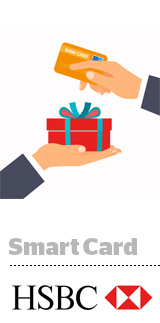
Credit card loyalty programs are table stakes for banks – nearly every bank has one. Points often accumulate unused and consumers sometimes forget they’re even there.
But HSBC uses data and artificial intelligence to personalize its offers and make its program more redeeming.
“There are so many choices in the credit card market, so we really need to find people who value our product relative to other choices,” said Brian Ahearn, HSBC’s director of card product management.
Historically, HSBC employed a traditional approach to re-engagement. The bank would pull a list of customers that fit a certain set of criteria, mail them an offer, wait to see what happened and then track the results in the back end over time.
There’s nothing wrong with that technique, but it didn’t tell HSBC what it really wanted to know, which was how to pinpoint the most appropriate offers for any given user, said Jesse Wolfersberger, chief data officer at Maritz Motivation Solutions, which has managed HSBC’s rewards program for several years.
“In other words, what is the right carrot to get people to be more connected with the brand and to move more business more efficiently?” Wolfersberger said.
To try and identify the best carrots for the job, HSBC worked with Maritz to examine usage and rewards redemption patterns among its credit card holders in relation to their point balance.
“With this intelligence, we could come up with a number of variables we felt to be predictive of intent,” Ahearn said.
HSBC used an algorithm devised by Maritz to identify which types of people might be inclined to redeem their points for certain offers, even if they had never redeemed for those offers before.
In a pilot test, HSBC sent emails to 75,000 cardholders based on suggestions made by the Maritz algorithm. Seventy percent of those who received the email offers and redeemed their points did so in a category recommended by the algorithm.
People who commonly spend money on public transportation and at drinking establishments, for example, are likely to be interested in travel. These traits aren’t necessarily obvious, but they make sense in retrospect, Wolfersberger said: Travelers aren’t afraid of other people and they like getting out of the house.
“If you’d started with the hypothesis first, though, you’d have looked at everyone who used points for travel in the past, which would only get you part of the way there,” he said.
That net wouldn’t catch those who may want to use their points for travel but haven’t yet, for whatever reason.
The goal here is to “open people’s eyes to the fact that there are other avenues for how they can use their points,” said Ahearn, who noted that HSBC is discussing how to turn the pilot test into an always-on program.
“Customers can see that their points have more utility and value than they may have previously been aware of,” Ahearn said. “We’re using data and algorithms to introduce ideas that may not be someone’s first preference but that are still very relevant.”
This post was syndicated from Ad Exchanger.


More Stories
Special PR makes Global PR Agency of the Year shortlist
Meta Stands to Lose Tens of Billions of Ad Spend in Impending FTC Antitrust Trial
Where kids’ books go bad: The Worst Children’s Library shocks parents